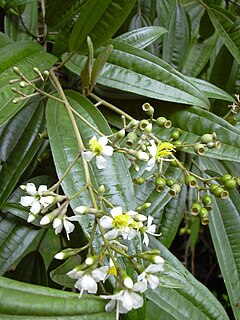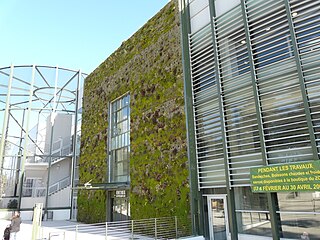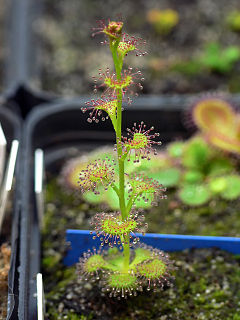
The beardfishes consist of a single extant genus, Polymixia, of deep-sea marine ray-finned fish named for their pair of long hyoid barbels. Until recently they were classified in their own order Polymixiiformes. But as Nelson says, "few groups have been shifted back and forth as frequently as this one, and they were recently added to Paracanthoptergii". For instance, they have previously been classified as belonging to the Beryciformes. They are of little economic importance.

Guillaume Rondelet, also known as Rondeletus/Rondeletius, was Regius professor of medicine at the University of Montpellier in southern France and Chancellor of the University between 1556 and his death in 1566. He achieved renown as an anatomist and a naturalist with a particular interest in botany and ichthyology. His major work was a lengthy treatise on marine animals, which took two years to write and became a standard reference work for about a century afterwards, but his lasting impact lay in his education of a roster of star pupils who became leading figures in the world of late-16th century science.

Pierre Magnol was a French botanist. He was born in the city of Montpellier, where he lived and worked for most of his life. He became Professor of Botany and Director of the Royal Botanic Garden of Montpellier and held a seat in the Académie Royale des Sciences de Paris for a short while. He was one of the innovators who devised the botanical scheme of classification. He was the first to publish the concept of plant families as they are understood today, a natural classification of groups of plants that have features in common.
Clusiella is a plant genus of the family Calophyllaceae. When Planchon and Triana first published it in 1860, based on Clusiella elegans, the genus was considered monotypic and remained as such for about 100 years.

Isotype is a method of showing social, technological, biological, and historical connections in pictorial form. It consists of a set of standardized and abstracted pictorial symbols to represent social-scientific data with specific guidelines on how to combine the identical figures using serial repetition. It was first known as the Vienna Method of Pictorial Statistics, due to its having been developed at the Gesellschafts- und Wirtschaftsmuseum in Wien between 1925 and 1934. The founding director of this museum, Otto Neurath, was the initiator and chief theorist of the Vienna Method. Gerd Arntz was the artist responsible for realising the graphics. The term Isotype was applied to the method around 1935, after its key practitioners were forced to leave Vienna by the rise of Austrian fascism.

Jules Émile Planchon was a French botanist born in Ganges, Hérault.

Rollinia is a genus of plants in the family Annonaceae. While it is widely recognised as a distinct genus a recent monograph advocates its inclusion in Annona, which also contains custard apples and soursops.

Rinorea is a genus of plant in family Violaceae.

Tetrazygia is a genus of flowering plants in the family Melastomataceae. They are native to the Antilles, and one species also occurs in Florida in the United States. The circumscription of the genus has been debated, but in general, about 25 species are accepted. Clover ash is a common name for plants in this genus.

The Great French Wine Blight was a severe blight of the mid-19th century that destroyed many of the vineyards in France and laid waste the wine industry. It was caused by an aphid that originated in North America and was carried across the Atlantic in the late 1850s. While France is considered to have been worst affected, the blight also did a great deal of damage to vineyards in other European countries.

The Montpellier Zoological Park is a French zoological park located in the region Occitanie, in the north of the city of Montpellier.

Drosera subg. Ergaleium, collectively known as the tuberous sundews, is a subgenus of three sections of tuberous species in the genus Drosera. The three sections represent natural groups, including the rosetted species, the fan-leaved species, and the erect or scrambling species.

Xanthoria elegans, commonly known as the elegant sunburst lichen, is a lichenized species of fungus in the genus Xanthoria, family Teloschistaceae. Recognized by its bright orange or red pigmentation, this species grows on rocks, often near bird or rodent perches. It has a circumpolar and alpine distribution. It was one of the first lichens to be used for the rock-face dating method known as lichenometry.
Ampelocissus barbata is a species of liana in the grape family Vitaceae. It was originally described from Sylhet by Nathaniel Wallich and placed in the genus Vitis. The species was moved to Ampelocissus by Jules Émile Planchon in 1884.
Acropora elegans is a species of acroporid coral that was first described by Henri Milne-Edwards in 1860. Found in sheltered, sloping reefs, this species occurs at 30 to 60 m depth. The species is listed as vulnerable on the IUCN Red List, and has a decreasing population. It is not common and has a small range, and is listed under CITES Appendix II. It is more resistant to disease than other Acropora species.

Doliocarpus is a genus of flowering plants in the family Dilleniaceae, native to Central and South America.
Saprosma elegans is a species of flowering plants in the family Rubiaceae. It is found in Indonesia.
Paroplitis is a genus of braconid wasps in the family Braconidae. There are about five described species in Paroplitis.












